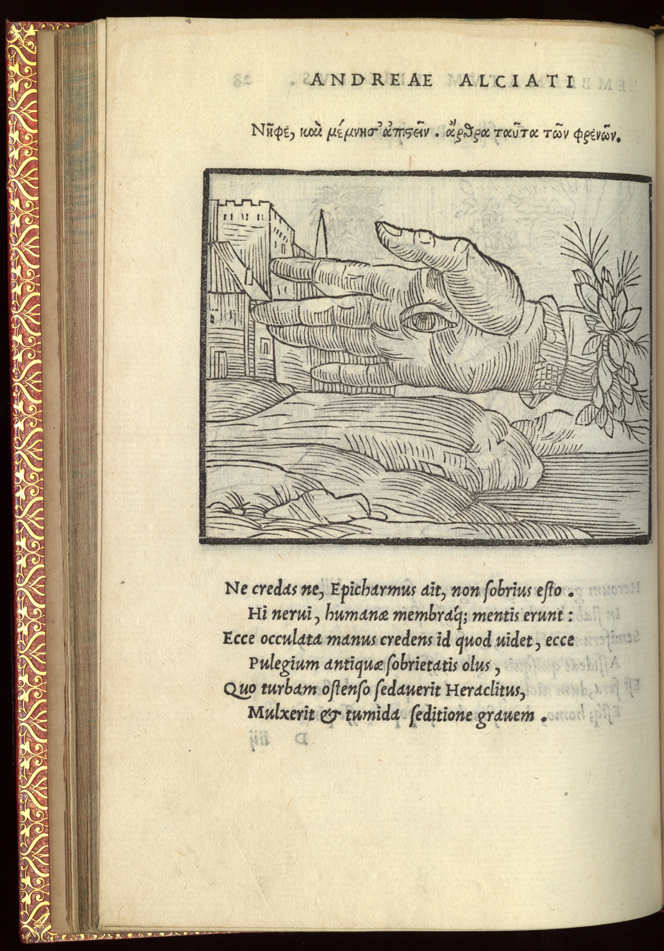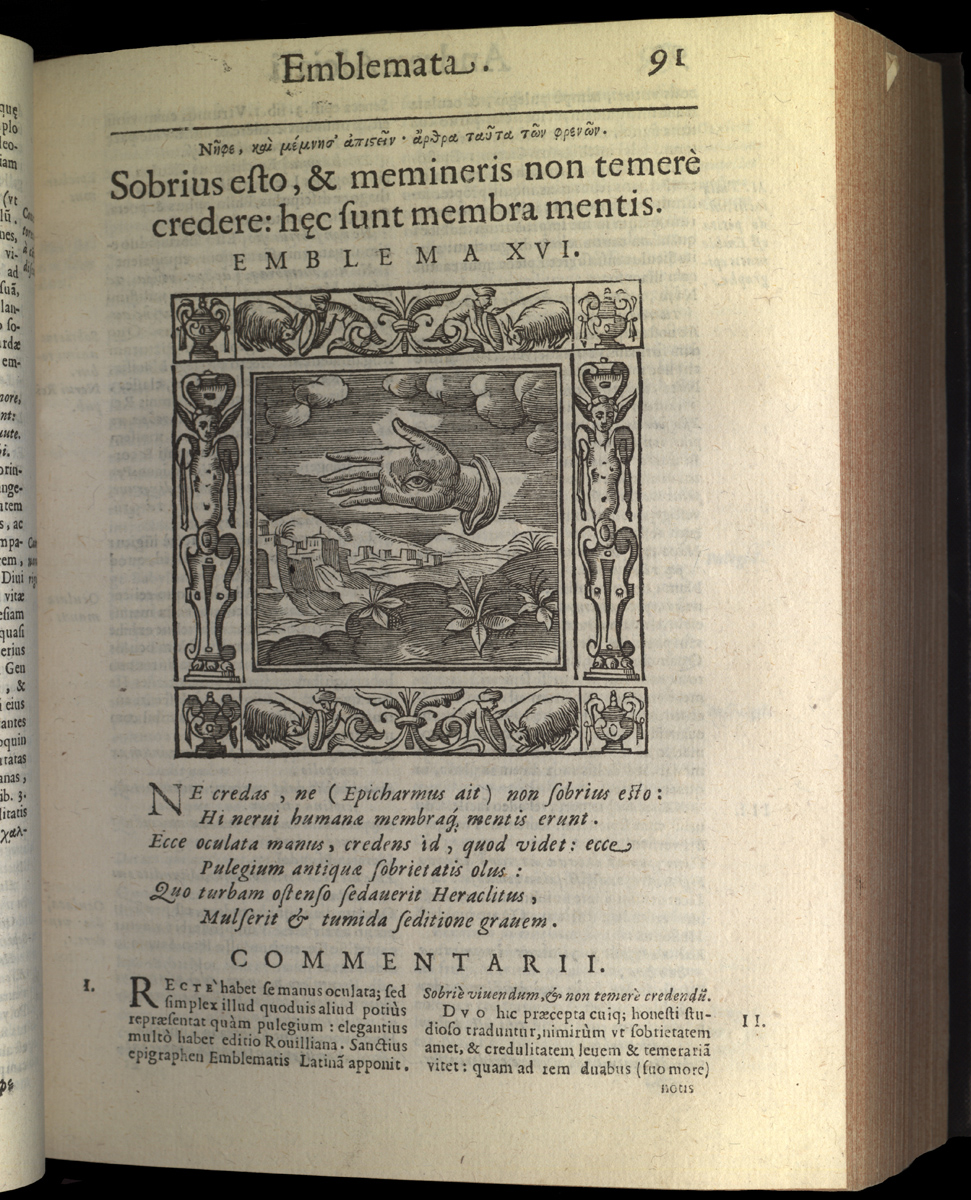7.03 Emblem as Machine
Emblems functioned as machines for interpretive reading, and as such they could be tools for teaching study skills. A few examples will show how this was so. The simplest emblems make us think immediately of classroom reading exercises, even though we know they were not originally intended for that purpose. In Alciati's Emblem 126, under the motto "From one man's loss, another's gain" (Ex damno alterius alterius utilitas), the reader is invited to imagine a lioness and a boar in mortal combat while a vulture sits watchfully in a nearby tree. The poem describes the action in simple verse, deliberately rustic in style and reminiscent of an Aesopian fable. The final line, again after the fashion of Aesop, offers an epigrammatic saying or moral, "The trophy of the victor will be another's [the vulture's] plunder." (7) This moral, however, was the second one given to the reader, since he had already been told in the motto that one man's loss produces another's gain. Equally deliberately, the story is a little more complex than Alciati's rustic style or either pithy saying alone allowed. The attentive reader would notice that there were two winners and one loser in the story, while the motto described one winner and one loser, and the moral epigram named the two winners but merely implied a loser.

The printed image could complicate the reading of the emblem or simplify it. In Alciati's first emblems, there were no visuals, only the poems and mottoes. One of the pleasures of the puzzle --something that recommended it as a pastime-- was that the poem invited the reader to visualize the scene for himself. In the case of an animal fable like that of the lioness, boar, and vulture this process did not in fact require much imagination since the animals in question had a familiar iconography. A printed emblem complete with image was puzzling in a different way, since the reader might not at first see how the meaning of the motto at the top of the page related to the picture. In the visual dynamic of the printed emblem, motto and picture are captured by the eye at once, but only carefully reading the poem in a second moment could resolve the tension between motto and image. Emblem 126 of the lioness and boar comes from the second published collection of Alciati's emblems, offered by the Aldine press in 1546. By this time, Alciati's earlier collection had been in print for fifteen years and the learned inventor knew that his new emblems would be presented with images. The result in this case of an animal fable was a simple, clearly described image easily translated by the artist.

Many of Alciati's emblems, however, were less naturalistic in form and lent themselves less easily both to visualization and to reading. Emblem 16 in modern editions is also from the 1546 collection and is among the more mysterious, at least on the face of it. Certainly it requires a complex reading. The picture shows an enormous, disembodied hand floating over a rural landscape. In some versions the artist dotted the fields with flowers; in others, a single oversize flower floats alongside the hand. On the open palm of the hand, an eye stares out at the viewer. The motto appeared in both Greek and Latin, telling the reader at once that the author had found an interesting Greek text and was going to translate it both literally and into an emblem. The Latin translation was unusually wordy for Alciati; it exhorted the reader to be careful, not to believe too easily, for "these are the limbs of the mind" (haec sunt membra mentis). No reader could be expected to resolve the enigma posed by the image and motto with any degree of certainty unless he could also get some hints from the poem. Even then, the reader was made to work. The entire poem reads:
Do not be credulous, do not be incautious, says Epicharmus. These will be the sinews and limbs of the human mind. Behold a hand with an eye, believing what it sees. Behold the pennyroyal flower, ancient symbol of sobriety. By displaying it [the flower] Heraclitus calmed the crowd and charmed it, though it was threatening with swelling sedition.

This poem is not entirely self-explanatory, but at least it identifies the source of the quotation, tells an ancient story (which is not pictured), and gives a token meaning to the items that are in the picture, the pennyroyal and the odd, seeing hand. The functional dynamic of the emblem, however, can only be explained in terms of Renaissance memory theory, which held that a striking, if possible slightly weird image was easier to remember than an ordinary one. Indeed, the full force of the emblem depends on memory in several ways. The reader must first remember at least vaguely the story of Heraclitus. She or he must be willing to accept a miscellaneous grouping of objects as a memory device. It would help too if the reader had a good memory for Latin vocabulary and knew that the adjective oculata (here applied to the hand) often referred to eyewitnesses in a court room. A person who offered reliable testimony by distinction to mere hearsay was oculatus. At this level, the emblem required multi-level, retrospective reading. It was intended to provoke a strenuous exercise of memory and moral analogy, both personal and historical. (8)
NOTES
- Open Bibliography
- (7) My translations, here and elsewhere in this chapter, are adapted from the online Alciati, www.mun.ca/alciato.
- (8) On mnemonic dimensions of emblems, Neuber 1990, 245-248, 255-257; on Heraclitus and moral analogy, Stafford 1999, 105. For the manus oculata symbol as a merchant's device, see Sabbioneta 2003, 61; it also appeared as an entirely decorative element in at least one mathematics textbook, Bettini 1642, vol. 2, pt. 2, p. 9.